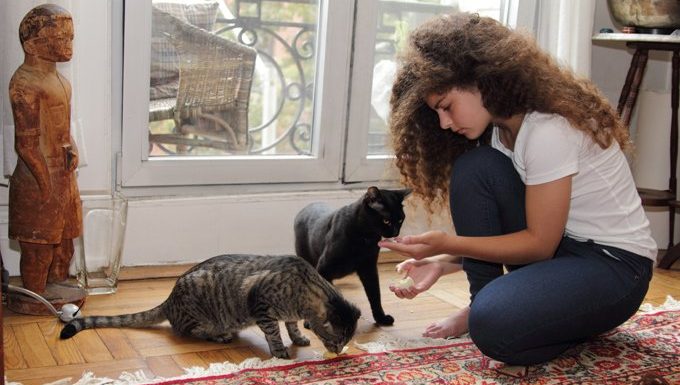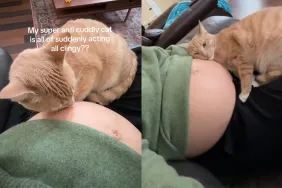This article courtesy of PetMD.com.
Hyperthyroidism in Cats
Hyperthyroidism is a disease caused by overproduction of thyroxine, a thyroid hormone that increases metabolism in the body. The thyroid gland normally produces thyroid hormones in response to stimulation by the pituitary gland, the “master gland” of the body. Thyroid hormones normally increase chemical processes occurring within the cells of the body, especially those related to metabolism; however, in hyperthyroidism, the excessive hormone levels push the cells and body into overdrive, resulting in increased metabolism with concurrent weight loss, anxiety, and diarrhea, among other symptoms.
There is no known genetic predisposition for hyperthyroidism, but it is quite common in cats. In fact, hyperthyroidism is the most common hormonal (endocrine) disease in the cat population, often seen in late middle-aged and older cats. (The mean age of discovery is approximately 13 years, with a range of 4-22 years.)
Symptoms and Types
- Involves many organ systems due to the overall increase in metabolism
- Weight loss
- Increased appetite
- Unkempt appearance
- Poor body condition
- Vomiting
- Diarrhea
- Increased thirst (polydipsia)
- Increased urine (polyuria)
- Rapid breathing (tachypnea)
- Difficulty breathing (dyspnea)
- Heart murmur; rapid heart rate; particularly an abnormal heart beat known as a “gallop rhythm”
- Hyperactivity
- Aggression
- Enlarged thyroid gland, which can be felt as a lump on the neck
- Thickened nails
Less than 10 percent of cats suffering from hyperthyroidism are referred to as apathetic. These patients exhibit atypical signs such as poor appetite, loss of appetite, depression, and weakness.
Causes
- Overfunctioning thyroid nodules (where the thyroid nodules produce excess thyroid hormones outside of the control of the pituitary gland)
- Rarely, thyroid cancer
- Some reports have linked hyperthyroidism in cats to some canned food diets
- Advancing age increases risk
Diagnosis
The signs of feline hyperthyroidism can overlap with those of chronic renal failure, chronic hepatic disease, and cancer (especially intestinal lymphoma). These diseases can be excluded on the basis of routine laboratory findings and thyroid function tests. Your veterinarian will conduct a battery of tests to zero in on a reliable diagnosis.
Thoracic radiography and echocardiography may be useful in assessing the severity of myocardial disease. Abdominal ultrasound may be useful for exploring underlying renal disease.
Thyroid gland scintigraphy (a diagnostic test in which a two-dimensional picture of a body radiation source is obtained through the use of radioisotopes) can be used to diagnose hyperthyroidism and to determine the location of abnormal thyroid tissue. A high concentration of T4 (tetraiodothyronine) in the blood serum is the most common finding, confirming the diagnosis of hyperthyroidism. In some cases, however, the T4 levels may be in the normal range, making a diagnosis of hyperthyroidism more difficult. This is especially true in the early stages of this disease. If your cat is showing the symptoms of hypothyroidism but the blood tests are not conclusive, you will need to return to your veterinarian for further blood tests.
Treatment
Outpatient management is usually sufficient if drugs that inhibit the production of thyroid hormones can be used. Surgical removal of the thyroid gland, or treatment using a radioactive form of iodine will require inpatient treatment and monitoring.
Surgical removal of the thyroid gland is best performed when only one thyroid gland is affected, as removal of both can possibly lead to hypothyroidism. Another complication that can occur after surgical removal of the affected thyroid gland is the successive hyper-activity of the remaining thyroid gland.
The use of radioiodine is restricted to a confined medical facility, since the treatment itself is radioactive. Depending on the state in which you live and the guidelines in place, your cat will need to be hospitalized from several days to a few weeks after being treated with radioactive medicine, to allow the radioactive material to clear most of the body before the cat is handled by family members. Precautions will still need to be taken after taking your cat home, to reduce your risk of having a toxic reaction to the radioactive treatment. Your veterinarian will advise you in precautionary measures.
Anti-thyroid drugs can also be effective. However, drugs to control thyroid activity often must be give for the life of the cat. In rare cases, untreated hyperthyroidism can lead to congestive heart failure, which requires emergency, inpatient intensive care. Poor absorption of nutrients and high metabolism in untreated hyperthyroidism suggest the need for a high protein, highly digestible diet; that is, one that can be quickly absorbed into the body.
Once the major symptoms resulting from excessive levels of thyroid hormones in the body have been resolved, dietary modifications often do not need to be strictly enforced. Even so, dietary modifications may be necessary to treat or control complications such as kidney damage.
Living and Management
Once treatment has begun, your veterinarian will need to reexamine your cat every two to three weeks for the initial three months of treatment, with a complete blood count to check for serum thyroid hormone concentration of T4. The dosage of the medications will be adjusted to maintain T4 concentration in the low-normal range.
If your cat has had surgery, particularly removal of the thyroid gland, your veterinarian will want to closely observe the cat’s physical recovery. Development of low blood-calcium levels and/or paralysis of the voice box during the initial postoperative period are complications that will need to be watched for and treated, should they occur. Your doctor will also be measuring thyroid hormone levels in the first week after surgery and every three to six months thereafter, to check for recurrence of thyroid gland over activity.
This article originally appeared here on PetMD.com.









